
Location: Mordiallic, VIC
Established: 1913
Architect: J.D. Scott & R.J. Banks
First Played: 26th May 2013
Last Played: 13th Oct 2017
Magazine Ratings

22 (Current)

25 (Current)
Returning from an extended holiday to the US, the opportunity came up to play Woodlands Golf Club for its foundation day, celebrating 100 years. This was to be the 45th course played from Australia’s Top 100 Golf Courses and what better way than a course from the top 20 (note it has dropped since originally played).
Well that was the original intro when I played. Unfortunately not much else was written after that visit in 2013, so I made the effort to revisit again in October 2017 before the top 100 was completed, currently sitting at 96 played. For that reason you will see a mix of photos, the first time it was extremely overcast.

Entrance to Woodlands Golf Club
Woodlands is located within the Sandbelt region of Melbourne, however it is not a part of the group considering themselves to be Sandbelt courses (Royal Melbourne, Victoria, Metropolitan, Commonwealth, Peninsula, Huntingdale and Yarra Yarra). Bit of a shame, as it is definitely a great track. Tom Doak has stated ‘if Dr Alister Mackenzie set foot at Woodlands, I suspect that it would outrank Metropolitan and Victoria as the third best course in the Sandbelt’. Certainly a big claim, but with some merit.

Clubhouse at Woodlands Golf Club
A new clubhouse was built in 2010 which overlooks part of the course. I had never been to the old clubhouse, so have no comparison, but seems to be a good place to socialise after the round. There is a large outdoor area at the rear, to enjoy the Melbourne sunshine (when it isn’t too cold or overcast). On both visits a nice BBQ lunch was enjoyed outside.

Men’s locker room at Woodlands Golf Club
Seven years later the facilities still look brand new, including the locker room, which is very modern. I sometimes enjoy the quaint style of yesteryear, which adds character and visualise history with a club of such age.

Map of Woodlands Golf Club
This is quite a tight course in parts, within a small parcel of land. At various stages, you need to double back a little to get to the next tee. If not paying attention to some of the direction signs, it is quite easy to lose your way and end up on the wrong tee.
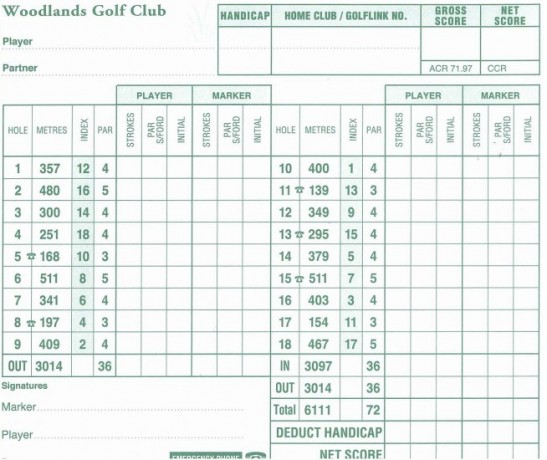
Woodlands Golf Club Scorecard
Visit 1 – It was a shotgun start for the event, having us tee off on the 2nd hole, however the review will be done in the traditional hole order. I was playing with three other guests, Ian, Paulo and his partner (whose name I cannot remember).
Visit 2 – Again a shotgun start, but this time starting on the 10th. Playing partners were Mick, Chris and Dean. I had played with Dean at some other open day, but we could not figure out where.
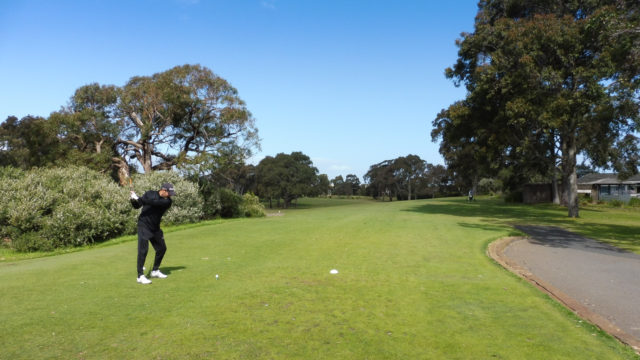
Hole 1 – 357 meter par 4 – Dean teeing off
Starting the round is a medium length par four which dog legs to the left. From an elevated tee there is ample fairway to land the ball, but those trying to cut the corner may find trees if not long enough. Finding the far side of the fairway leaves the best angle for an approach. Being on the left side may bring the green side bunkers into play, mainly if the trees have been found trying to shorten the hole.

Slight uphill shot to the 1st green
The green has a small but steep slope at the front and right side, making it easy for the ball to feed away, however the rear slopes back onto the putting surface. One thing evident straight away was the firmness of the greens. Longer clubs or slightly mishit would make it more difficult holding the putting surface. A hole which eases you into the round with its fairway width and open green, but a confusing strategy.

Hole 2 – 480 meter par 5
Playing along the southern boundary, this long par 5 is relatively straight, but does play with a slight kink to the right. From the tee it plays up a gentle incline, with bunkers found down the right. For most, playing down the centre will allow an easier shot to layup for the approach, or open the green up if attempting to reach in two. The bunkering does assist in making players keep well away from the out of bound area down the right side of the hole.
I did notice that a new area of heath was being grown just in front of the teeing area, something which had changed since the previous visit. Most sandbelt clubs are doing this (or have done this) to try and conceal the walkways. Not sure this one will have the same effect however as they unusually angle the walkway to allow the heath to hide the path.

A long but narrow 2nd green
After reaching the rise, the fairway plays down a gentle incline to the green complex. Slightly raised, this has two traps on the right, one slightly short of the green, whilst another is built into the left side. With the positioning of these, play is much easier from the left side of the fairway. The putting surface is long and narrow. Anything not dead on line may run away down the numerous slopes around the green. The one good thing about Woodlands Golf Club, is the tight grass on most of the green surrounds. This allows some imagination in how to get the ball to the hole. A little more thought required on this hole, particularly with the run in.

Hole 3 – 300 meter par 4
The first of the short par 4 holes, this has a dogleg right. Down the right are a series of bunkers, heavy grass and trees, although slightly back. First instinct for most will be trying to cut the corner to either shorten the hole or reach the green. The latter is not likely. Ideally finding the far left of the fairway is essential.

The 3rd green is raised and protected by two large bunkers
With the green side bunker positioning leaving a narrow entrance, this hole has the ideal line in from the left of the fairway. The green, like most at Woodlands Golf Club sits slightly raised, so accuracy is key. With such a small green it is easy to find your ball running down the slopes covering the rear section. The hole plays totally opposite to how it appears where the tee shot should found the outside of the turn, its just a case of how much risk is taken to get it there. Being fairly short there is no real opportunity to hit the green, especially with the bunker positioning, although if you favour a left to right ball flight, there is a slim chance.

Hole 4 – 251 meter par 4
Consecutive short par 4s, although this is the shortest, but also the easiest indexed hole on the course. There are many ways to play the hole which is relatively straight. A fairway trap is located to the right, with ample fairway found in front of it. Beyond it tightens a little on the left, but still has a bit of room beyond the bunker.
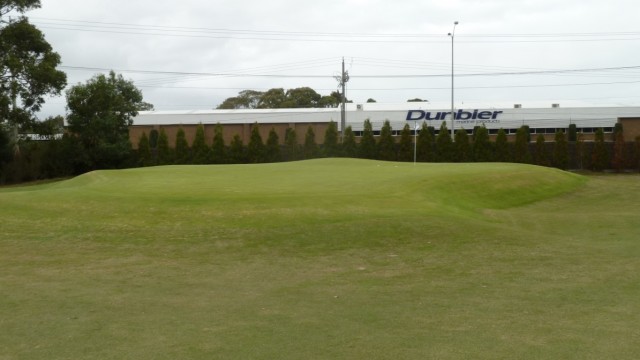
The small but raised 4th green makes a tough target on this short par 4
With a green which is raised, and quite narrow at the front, it is important to leave yourself in the correct position to make the approach. Those trying to drive the green may have some difficulty if finding themselves on either side. Certainly at the front, playing the wrong shot may see the ball run across the putting surface and down the opposite slope. Although small in length, this can be a punishing hole if you get the execution of your strategy wrong.
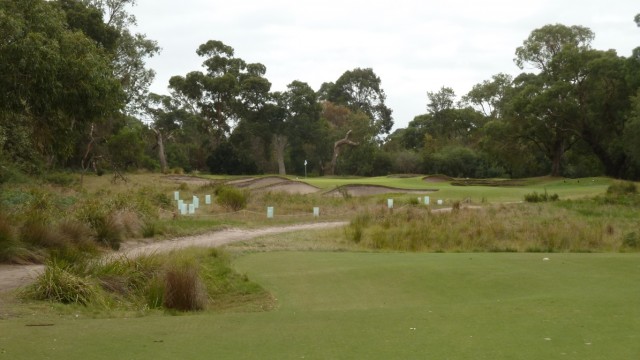
Hole 5 – 168 meter par 3
Coming to the first par 3 of the day, is a mid length hole with numerous bunkers surrounding the green complex. From the left these angle across the front of the green, but leave a bit of space between the sand and putting surface. This allows for a missed shot short right.

Bunkers surround the 5th green
A couple of more bunkers are beside the green on the right, which is also the same side the green angles away from the tee . One noticeable thing with the putting surface, it is not raised like the first four. Slightly testing hole with its narrow green where club selection will be critical, but still a joy to play.

Hole 6 – 511 meter par 5
A par 5 follows, which is the equal longest hole on the course. A carry over a small section of heath is required before reaching the fairway. This hole turns left, then slightly right before reaching the green. The fairway is quite wide, but finding yourself too far right, will put you out of position for the second shot, with trees starting to encroach from the same side. Ideally playing down the left side leaves a clearer view.

Looking back from the 6th green
Some strategy comes into play with the second, with an area of small hillocks and rough encroaching from the right. Either play short, around or try and carry to leave a short approach. Finding yourself to the right of the fairway leaves an easier shot into the green, with bunkers lining the right side, starting well short of the putting surface. It also allows some of the left to right sloping on the green to be negated. Good par 5 offering a variety of choice with every shot from tee to green.

Hole 7 – 341 meter par 4
Heading in the opposite direction is this mid length par 4 which doglegs to the left. I also noticed that the area around the ladies and social play had been vegetated with more natural grasses than my previous visit. Trees run along either side of the fairway, which is quite wide until around the 220m mark. Here it narrows dramatically. Those too far right on the fairway may not have a clear shot to the green.

Cut the corner of the 7th fairway to have a short approach to the green
The green itself has numerous bunkers at the front leading into the green and on the left. Interestingly a small portion of the putting surface sticks out to the right unprotected, although a couple more can be found behind this section for those taking too much club. My first thoughts when playing years ago, was that it was a great hole. I don’t share those feelings so much years later. It does offer some risk from the tee, threading the needle of a fairway at its narrowest point, but bunkers basically block most shots into the green. Finding the right hand side, does not offer a clearer shot in, due to the trap positioning. This limits how the hole can be played quite a bit.

Hole 8 – 197 meter par 3
Starting the run back to the clubhouse is the longest and hardest par 3 on the course. A small area of sandy waste must be carried before finding the generous amount of tight grass leading into the green. Bunkers are down the left side, one of them short of the green, but ample room is found short right. This is the ideal area to miss, allowing a shot onto the green.
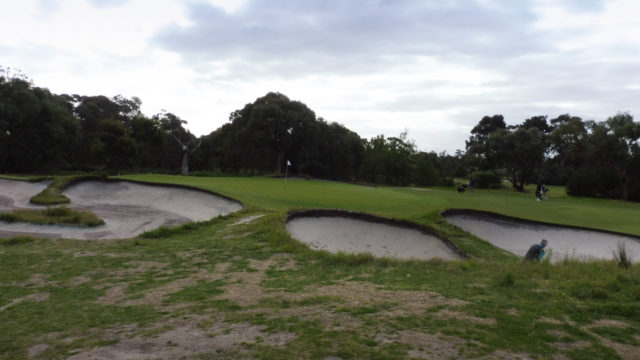
Bump and run if wide of the 8th green – one of the great things about Sandbelt golf
The green slopes from the rear to front, with the latter portion sloping more steeply towards the surrounds. Another trap is found on the right side, so anyone not quite confident on their sand play should avoid them. If conditions get up this becomes one tough hole at its full length. I like it though as it allows those not so confident an area to play safely.

Hole 9 – 409 meter par 4
To finish the front loop is the longest par 4 on the course. Playing over a slight hill to a wide fairway, the ball will disappear as the land slopes away. As we get closer to the green the fairway narrows, with trees down either side. The left side of the fairway allows a clear view to the green.

Even after a great tee shot you face a long approach to the 9th green
Two large bunkers are found short right of the green complex, which has a large green. The putting surface itself is quite flat, but the surrounds all lead away. Not an exciting hole but testing none the less. There is an ideal line, but a variety of shots can be made to get the ball to the hole.
On my second visit a temporary green was in play, due to the ongoing greens renovation project being carried out. This involves replacing two greens at a time. Not sure how long the project has been going, or how long it has to remain however.


Hole marker and pin flag
Nothing too fancy when it comes to the tee markers. Basically the standard plaques with hole number, length and par. Interestingly they also contain the clubs old emblem, a tree. The pin flags have the clubs new logo, more in style with the older more traditional clubs with letters intertwining.

Hole 10 – 400 meter par 4
Starting the second loop is the hardest hole on the course. A long par 4 which will require two well struck shots to reach. Playing to a small ridge, a fairway trap is located to the right. There is some width, but hitting down the bunker side side certainly opens up the green to all pin positions.

The approach to the 10th green has some bunkers to contend with
Traps line the left side of the green, but then extend quite far forward, eventually coming across to the middle of the fairway. For those not confident of carrying the forward bunker, or out of position, there is some space to the right, but there is quite a lot of room between the bunker and green. A slightly risen putting surface, like most on the course, is more noticeable on the right and rear. Challenging hole but offers a bit for all levels of golfer with different strategies available.

Hole 11 – 139 meter par 3
Next is the shortest hole on the course. A carry over native grass is required to reach the green complex.

Medium length par 3 – the 11th is protected by a large bunker
This par 3 is well protected by three bunkers, although a small opening is still available on the left side of the green. The medium sized putting surface has some gentle slopes to contend with. Nice short hole which is all about finding the right club selection. Finding the wrong portion of the bunkers could leave a very tricky shot however.
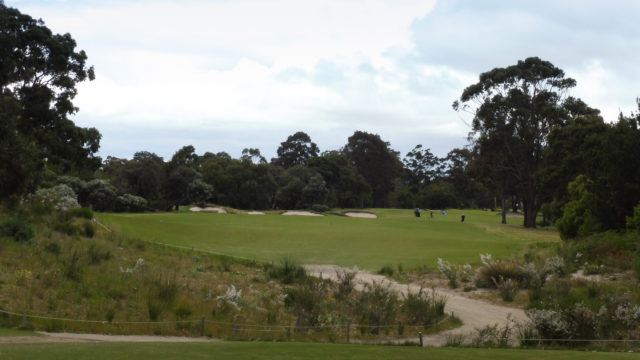
Hole 12 – 349 meter par 4
Coming to this mid length par 4, there is some risk verse reward on offer from the tee. The fairway is quite wide for those who may use a long iron, but narrows dramatically for anything higher. Bunkers narrow the fairway from the left, whilst a large tree encroaches from the right.
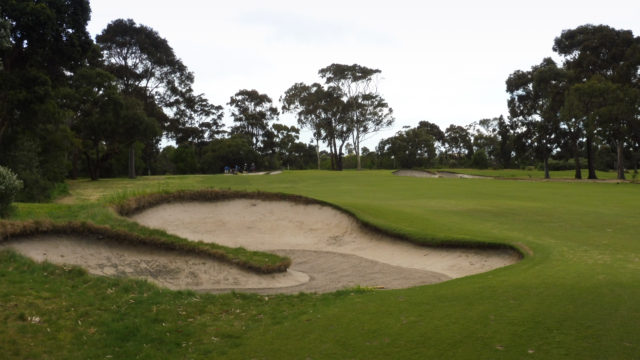
Great Sandbelt bunkering – the 12th green
Being more right from the tee allows the green to open up slightly for most pin positions, in particular back right positions. This is due to the green angling away to the right, with a front and rear bunker. Really like the angles in play on this hole and the strategy from tee to green.

Hole 13 – 295 meter par 4
Another short par 4 is found on the 13th, which doglegs to the right. Trees and a bunker complex short of the green are down the inside of the turn. The traditional way of playing this hole is hitting down the left side of the fairway, as close as possible to the large bunker system, which opens the angle for the second shot.

Playing too far left leaves a difficult approach to the 13th green
Longer hitters may try and reach near the green, with space short and to the left, but with such a narrow green which angles away to the right, finding the putting surface will be almost impossible. Being quite narrow those finding themselves to the left have the potential of finding the right green side bunkers, if the shot is not hit perfectly. The green complex sits slightly raised and an abundance of short grass on its surrounds, allowing for a variety of shots to be played. One of the standout holes, with well positioned hazards and green complex.

Hole 14 – 379 meter par 4 – Ian signalling the wide – big mishit from the tee
A longer par 4 follows, playing predominantly straight. It almost feels like playing through a chute from the tee, with trees encroaching either side. One bunker is located to the right of the fairway, but really serves no use as the center of the fairway is the ideal line.

Avoid the bunkers on the right of the 14th fairway
The approach must thread a needle between two long sets of bunkers either side of the fairway. The right side stops short of the green, bu the left ends green side. Running the ball into this green is certainly an option, although playing long will run over a hump at the rear and leave a difficult shot back in. Certainly not the best designed hole on the course with no obvious lines other than hitting straight. The fairway bunker really serves no purpose and the approach is mainly about hitting straight. I shouldn’t say not the best designed, more not my favourite of design.

Hole 15 – 511 meter par 5
Heading back in the opposite direction is the equal longest hole and most difficult par 5 at Woodlands Golf Club. The 15th fairway looks narrower than it actually is, with trees encroaching from the side to obscure some of the width available. The tee shot can land anywhere on the fairway, although the right side gives a clearer view into the green.

The cross bunkers on the 15th fairway are in play
Playing the second shot will encounter a group of cross bunkers, coming in from the left. These are around 100 meters away from the green complex. For those not confident or out of position to carry, it is possible to maneuver around these on the right side of the fairway, but this brings bunkers further along into play.

Slightly raised 15th green
There is a small hollow found short of the green, which assists in giving further elevation to the complex. A deep bunker is located left, whilst the rear slopes away. Enjoyable par 5 with a bit of thought required on every shot, due to the well placed hazards.

Hole 16 – 403 meter par 4
Quite a long par 4, so it is good to see a wide open fairway from the 16th tee. With a slight kink to the left, there is a bunker located to the right of the fairway, but will not come into play for most players. The ideal line is center to right, opening the angle to the green.

Bunkers leading into the 16th green
With bunkers down the left leading into the green, play from the right side leaves a better angle. A smaller solitary bunker is right rear of the green. One of the few complexes that are not raised, allowing the ball to be run in from a long shot. Challenging hole, especially into a prevailing wind, which allows for a variety of play.

Hole 17 – 154 meter par 3
Not in play during my second visit, this medium length par 3. Protected by a large trap in front of the green, hitting the right distance becomes critical.

Bunkers surround the 17th green
Another trap is located right, with a few slopes leading of on various sides of the green complex. The putting surface is longer than it is wide, so club selection is critical in finding the correct portion. I like that there are various contours on the surrounds, which sees a variety of shots available, although the left and rear contain some rough area close to the green.

Hole 18 – 467 meter par 5
Coming to the last hole for the round, is a medium length par 5. From the tee a hill is encountered, which longer hitters may be able to take advantage of rolling down the opposite side. There is a lot of open space seen from the tee, although the fairway is not overly wide.

Approach from the 18th Fairway
A large bunker complex is found short of the green, crossing in from the right side of the fairway. Ample fairway is found around this, even for those not confident in carrying. Ideally finding the right of the fairway leaves a better angle into the green.

18th green with clubhouse in the background
Making the approach from the left side of the fairway is much more difficult, with bunkers found short left, then also green side. The right and rear drops away dramatically, leaving a difficult recovery shot. Really like the angles over the entire hole and use of the fairway slope. Not just a case of hitting the ball anyway, some thought must be given.
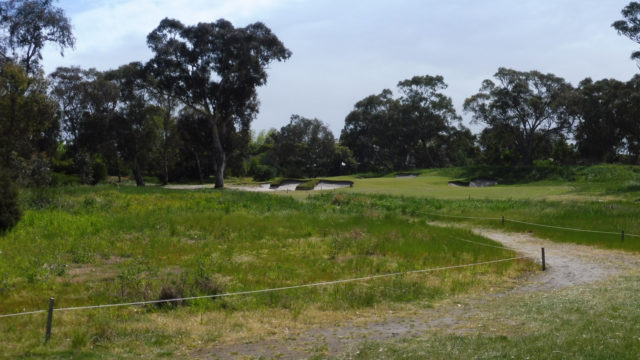
Hole 19 – 115 meter par 3
During my second visit the 17th hole was out of play, so this was my first experience with Woodlands extra hole. A short par 3, a carry over some native grass is required before finding an area of short grass leading up to the green. Generally the green complex has a large mound right, leading down into the green, before the green falls away over on the left.

The elevated 19th green
With a raised green, a small bunker is found front right and rear right, whilst a larger trap is located left. This is of a much more unusual design, with the rear blending into a sandy area, rather than a distinct edge. Very different to the rest of the course. The putting surface is of comparable size, with some distinct slopes. Pin positions to the left are protected by the bunker, but generally the green slopes towards this direction, allowing for the ball to be feed in. It is always good to have a spare hole, allowing the course to operate as normal as possible during reworks or resting periods, but most courses have something which feels a natural fit with the remainder of the course. This doesn’t feel quite the case in this instance.
Looking at the course makeup:
- Hole Directions – There was some variety allowing for conditions to have wide ranging effects during play with a fairly even split of the compass points. Although at times holes ran parallel to each other, efforts have been made in the routing to ensure this is kept to a minimum
- Hole Lengths – Par three holes had a good variance in distance, ranging from mid to long. The majority in mid length range. Par four holes ranged from short to long with an even split among the three groups. Par 5 holes ranged from mid to long with the long length being the majority. Balance of the par types was good as a whole. When looking at the two nine loops, there was some imbalance within lengths of par 4 holes. The front had a larger number of short, whereas the back had a large number of long par 4 holes
- Hole Layout – There was a good mixture in how the holes played, with an even split between those turning left or right, where two shots or more were required to reach the green
The condition of the course, was good considering the weather leading up to game day. The tee box areas had level surfaces and good grass coverage. These have been rotated on a regular basis. Fairways were in an excellent state. Quite firm and allowing for a bit of run. Bunkers were well maintained, with sand consistent in the bunkers I visited. You have to play from at least one bunker when in the Melbourne Sandbelt. Green complexes were firm yet receptive. The ball rolling generally true. We did find speeds slightly slower however than that of the practice green.
A few standout holes for me were 4, 6, 11, 12, 13, 14, 15 and 18. Seems like a liked the back nine a lot more than the front in hindsight. Overall a memorable course and I think how much better it still could be.
I once read a comment by Michael Clayton, stating that Woodlands Golf Club would be an even greater course if it returned to its origins, removing much of the vegetation. If you were spraying the ball dramatically I could see this being a major problem. I must admit I didn’t have too much issue during my round staying to the fairways. They were quite generous at times, but only if your were using the correct club. Woodlands has some distinct lines to allow the hole to open up, but has generous landing areas at times which will make the safe shot face a difficult approach to the green. I have not seen maps or photos from the original layout, but this does intrigue me.
Woodlands overall was a great course to play. Being located within the Sandbelt raised the expectations before playing, and I wasn’t let down. This course deserves its ranking within the top 25 of Australian courses. There is a lot of strategy required on a great percentage of the holes, making the game more enjoyable.
The course is a private course. To play at Woodlands Golf Course you will need to do one of the following:
1. Be invited by a member
2. Interstate or overseas visitor (must be a member of a golf club)
3. Play one of the open days held throughout the year. Keep an eye out on some of the Social Golf Club sites

